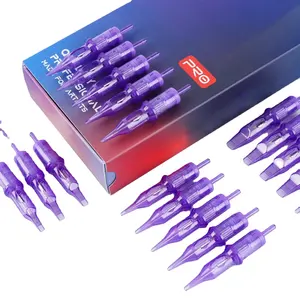
All categories
Featured selections
Trade Assurance
Buyer Central
Help Center
Get the app
Become a supplier

(189 products available)














































Self-threading needles are sewing tools that allow for easy and quick threading of the sewing thread without the need for a separate threader. They are especially useful for individuals with limited vision or dexterity. Here are some types of self-threading needles:
Self-threading needles are an innovative and practical tool for sewing and crafting. They come with a variety of designs that cater to different sewing needs. Here are some of their designs:
Needle with a Sliding Eye
This type of self-threading needle has an eye that opens and closes. To thread, one slides the eye open, places the thread in it, then closes it. This design is compact and protects the thread from damage.
Needle with a Spring-Loaded Eye
This needle has a spring-loaded eye that opens for threading and closes afterward. The user inserts the thread into the open eye, and the spring mechanism closes it. The design is quick and secure, ideal for those with poor vision or dexterity issues.
Needle with a Dual-Function Eye
This needle has an eye that can switch between self-threading and traditional threading. It allows users to choose their preferred method. The design is versatile and suitable for various thread types and sizes.
Needle with a Magnetic Thread Holder
This needle holds the thread in place with a magnetic thread holder. It threads like a traditional needle but keeps the thread secure with a magnet. The design is reliable and excellent for machine sewing.
Needle with an LED Light
This needle has an LED light that illuminates the eye for threading. It threads like a traditional needle but with a light to help see. The design is perfect for low-light conditions.
Self-threading needles are used in various sewing projects. Here are some wearing and matching suggestions for different tasks:
Wearing suggestions
When using a self-threading needle, wear comfortable clothing that allows ease of movement. Opt for fitted sleeves that won't interfere with the sewing process. Choose a well-lit location to work on detailed projects. Consider wearing reading glasses if needed for close-up tasks. Keep nails trimmed to handle small parts easily. If working on intricate designs, use a magnifying glass to see better. Maintain a steady hand to guide the fabric. Take breaks to avoid strain on the eyes and hands. Stay organized to keep all tools within reach. Lastly, enjoy the creative process and relax.
Matching suggestions
Self-threading needles match well with various fabrics. They are perfect for delicate materials like silk and chiffon. The needle's design prevents damage to the fabric's fibers. It is ideal for beginners and experienced sewers. The needle works with different thread types. It is suitable for hand or machine sewing. The self-threading feature saves time and reduces frustration. It is a great tool for quick repairs. The needle is also helpful for complex projects. It allows precise stitching and consistent results. Overall, it is a valuable addition to any sewing kit.
Q1: How does a self-threading needle work?
A1: A self-threading needle simplifies the threading process by using a slot or groove in the needle's body instead of a traditional eye. The user inserts the thread into the slot, and the needle automatically threads itself as the needle is pulled through the fabric.
Q2: Who can benefit from using self-threading needles?
A2: Self-threading needles are beneficial for individuals with vision impairments, dexterity issues, or those who find traditional needle threading challenging. They are also useful for experienced sewists looking for a quick and efficient threading method.
Q3: Can self-threading needles be used for all types of sewing?
A3: Yes, self-threading needles can be used for various sewing tasks, including hand sewing, embroidery, and quilting. They work well with different fabrics and thread types, making them versatile for various sewing projects.
Q4: Are self-threading needles suitable for quilting?
A4: Yes, self-threading needles are suitable for quilting. They can easily handle multiple fabric layers and batting, making them ideal for quilting projects. Their automatic threading feature saves time and effort when working with thick layers.